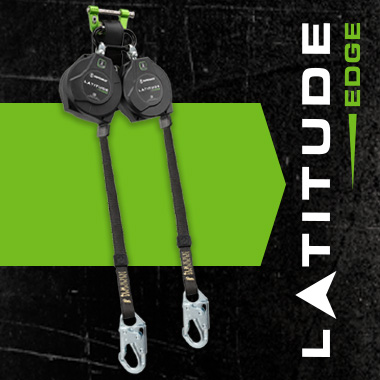The most important factors to consider when wearing a safety harness are the same whether it is one issued to a single worker or one that will be shared by multiple workers.
- The harness must always be a proper fit for the person wearing it. While every worker should check their harness for fit before each use, sharing a harness may mean it will need to be fully readjusted every time. Tongue buckle leg connections are often preferred for easier adjustment on a shared harness. Employees should be trained on how to properly fit the harness they will need to wear for the job.
- The harness must always be a proper fit for the work environment. A harness may be shared between workers but not necessarily between functions. What works for one application may not work in another and could even create a greater hazard. For instance, a padded shoulder may add comfort in construction but be too hot in a factory. Even more critical, a construction harness would not be safe to use in a welding or arc flash environment.
Yes. OSHA requires employers to provide fall protection for each employee exposed to fall hazards. They do not, however, require each worker to have their own equipment. A harness with universal sizing has five areas of adjustment – chest strap, two torso adjusters and two leg buckles – to provide for different body shapes and sizes when different workers may share the same harness.
The most important factors to consider when wearing a safety harness are the same whether it is one issued to a single worker or one that will be shared by multiple workers.
- The harness must always be a proper fit for the person wearing it. While every worker should check their harness for fit before each use, sharing a harness may mean it will need to be fully readjusted every time. Tongue buckle leg connections are often preferred for easier adjustment on a shared harness. Employees should be trained on how to properly fit the harness they will need to wear for the job.
- The harness must always be a proper fit for the work environment. A harness may be shared between workers but not necessarily between functions. What works for one application may not work in another and could even create a greater hazard. For instance, a padded shoulder may add comfort in construction but be too hot in a factory. Even more critical, a construction harness would not be safe to use in a welding or arc flash environment.
Yes. OSHA requires employers to provide fall protection for each employee exposed to fall hazards. They do not, however, require each worker to have their own equipment. A harness with universal sizing has five areas of adjustment – chest strap, two torso adjusters and two leg buckles – to provide for different body shapes and sizes when different workers may share the same harness.
The most important factors to consider when wearing a safety harness are the same whether it is one issued to a single worker or one that will be shared by multiple workers.
- The harness must always be a proper fit for the person wearing it. While every worker should check their harness for fit before each use, sharing a harness may mean it will need to be fully readjusted every time. Tongue buckle leg connections are often preferred for easier adjustment on a shared harness. Employees should be trained on how to properly fit the harness they will need to wear for the job.
- The harness must always be a proper fit for the work environment. A harness may be shared between workers but not necessarily between functions. What works for one application may not work in another and could even create a greater hazard. For instance, a padded shoulder may add comfort in construction but be too hot in a factory. Even more critical, a construction harness would not be safe to use in a welding or arc flash environment.
Yes. OSHA requires employers to provide fall protection for each employee exposed to fall hazards. They do not, however, require each worker to have their own equipment. A harness with universal sizing has five areas of adjustment – chest strap, two torso adjusters and two leg buckles – to provide for different body shapes and sizes when different workers may share the same harness.
The most important factors to consider when wearing a safety harness are the same whether it is one issued to a single worker or one that will be shared by multiple workers.
- The harness must always be a proper fit for the person wearing it. While every worker should check their harness for fit before each use, sharing a harness may mean it will need to be fully readjusted every time. Tongue buckle leg connections are often preferred for easier adjustment on a shared harness. Employees should be trained on how to properly fit the harness they will need to wear for the job.
- The harness must always be a proper fit for the work environment. A harness may be shared between workers but not necessarily between functions. What works for one application may not work in another and could even create a greater hazard. For instance, a padded shoulder may add comfort in construction but be too hot in a factory. Even more critical, a construction harness would not be safe to use in a welding or arc flash environment.

